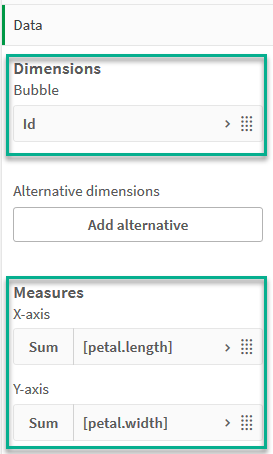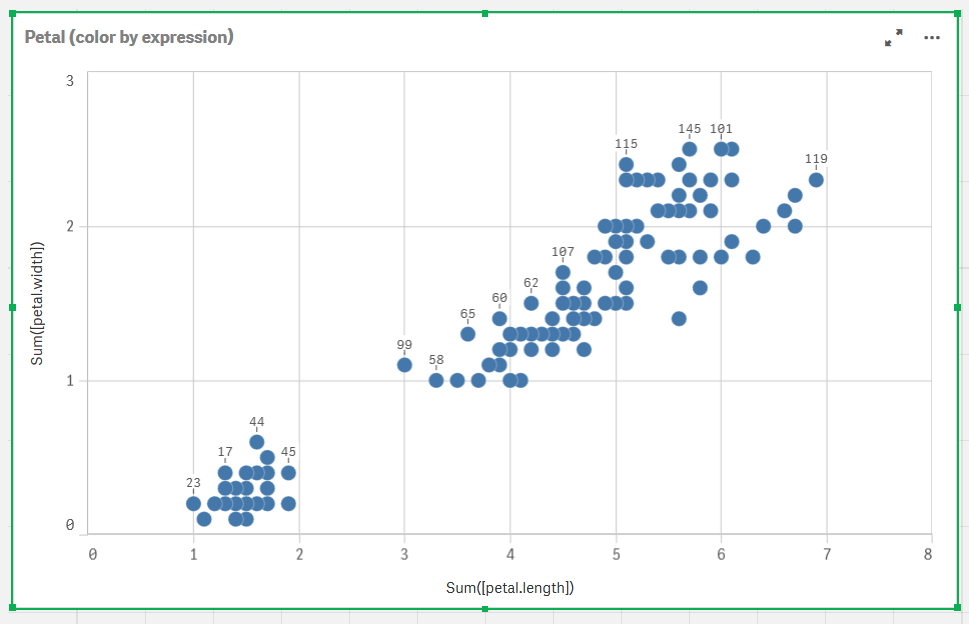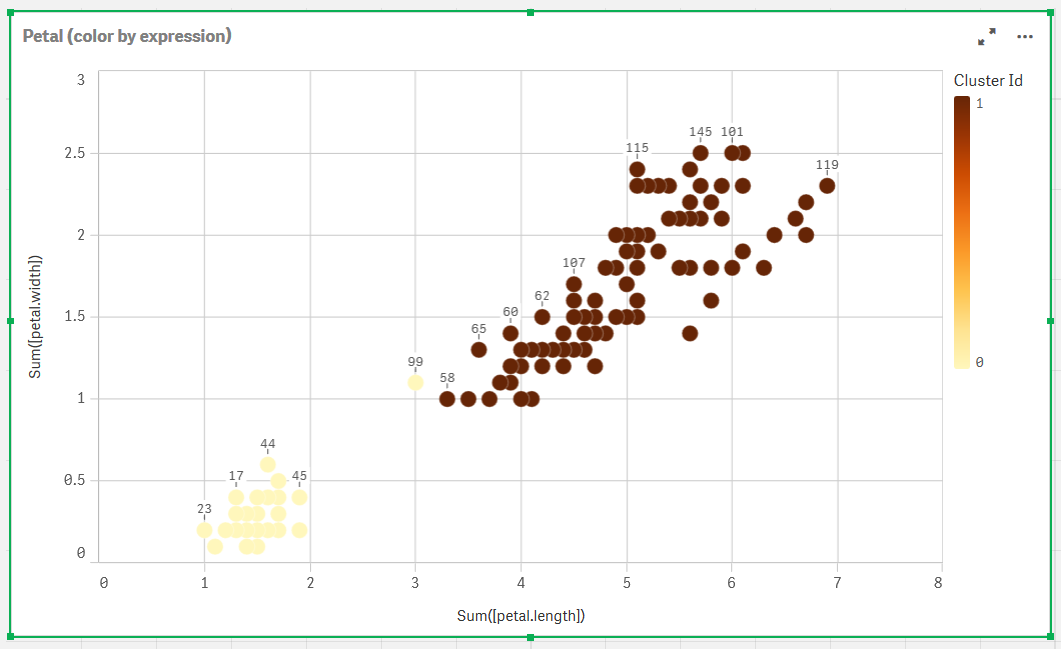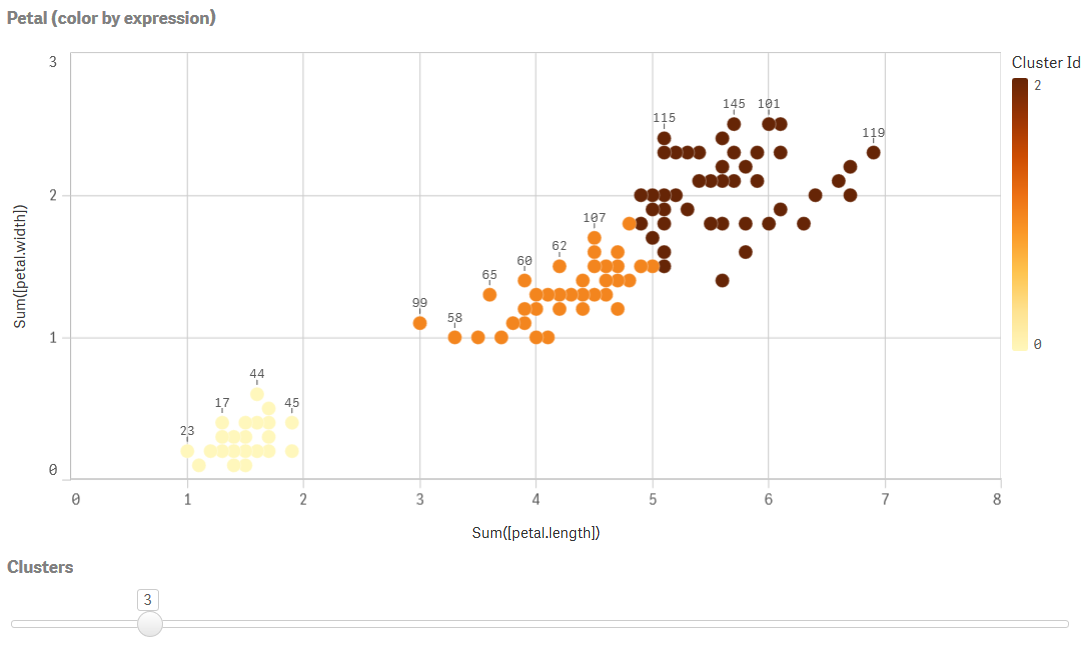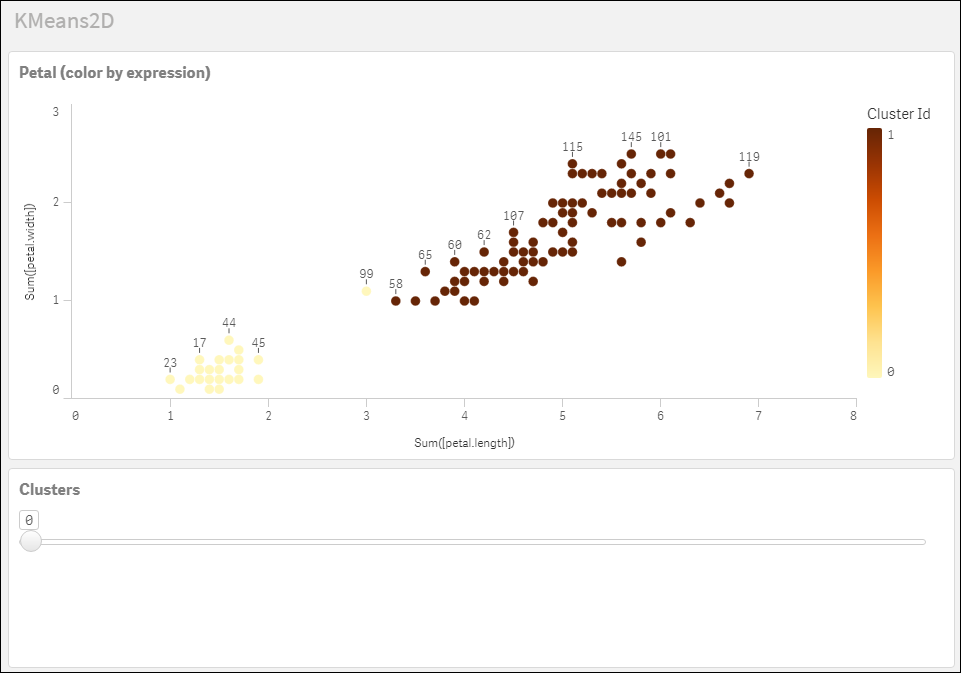IrisData:
Load * Inline [
sepal.length, sepal.width, petal.length, petal.width, variety, id
5.1, 3.5, 1.4, 0.2, Setosa, 1
4.9, 3, 1.4, 0.2, Setosa, 2
4.7, 3.2, 1.3, 0.2, Setosa, 3
4.6, 3.1, 1.5, 0.2, Setosa, 4
5, 3.6, 1.4, 0.2, Setosa, 5
5.4, 3.9, 1.7, 0.4, Setosa, 6
4.6, 3.4, 1.4, 0.3, Setosa, 7
5, 3.4, 1.5, 0.2, Setosa, 8
4.4, 2.9, 1.4, 0.2, Setosa, 9
4.9, 3.1, 1.5, 0.1, Setosa, 10
5.4, 3.7, 1.5, 0.2, Setosa, 11
4.8, 3.4, 1.6, 0.2, Setosa, 12
4.8, 3, 1.4, 0.1, Setosa, 13
4.3, 3, 1.1, 0.1, Setosa, 14
5.8, 4, 1.2, 0.2, Setosa, 15
5.7, 4.4, 1.5, 0.4, Setosa, 16
5.4, 3.9, 1.3, 0.4, Setosa, 17
5.1, 3.5, 1.4, 0.3, Setosa, 18
5.7, 3.8, 1.7, 0.3, Setosa, 19
5.1, 3.8, 1.5, 0.3, Setosa, 20
5.4, 3.4, 1.7, 0.2, Setosa, 21
5.1, 3.7, 1.5, 0.4, Setosa, 22
4.6, 3.6, 1, 0.2, Setosa, 23
5.1, 3.3, 1.7, 0.5, Setosa, 24
4.8, 3.4, 1.9, 0.2, Setosa, 25
5, 3, 1.6, 0.2, Setosa, 26
5, 3.4, 1.6, 0.4, Setosa, 27
5.2, 3.5, 1.5, 0.2, Setosa, 28
5.2, 3.4, 1.4, 0.2, Setosa, 29
4.7, 3.2, 1.6, 0.2, Setosa, 30
4.8, 3.1, 1.6, 0.2, Setosa, 31
5.4, 3.4, 1.5, 0.4, Setosa, 32
5.2, 4.1, 1.5, 0.1, Setosa, 33
5.5, 4.2, 1.4, 0.2, Setosa, 34
4.9, 3.1, 1.5, 0.1, Setosa, 35
5, 3.2, 1.2, 0.2, Setosa, 36
5.5, 3.5, 1.3, 0.2, Setosa, 37
4.9, 3.1, 1.5, 0.1, Setosa, 38
4.4, 3, 1.3, 0.2, Setosa, 39
5.1, 3.4, 1.5, 0.2, Setosa, 40
5, 3.5, 1.3, 0.3, Setosa, 41
4.5, 2.3, 1.3, 0.3, Setosa, 42
4.4, 3.2, 1.3, 0.2, Setosa, 43
5, 3.5, 1.6, 0.6, Setosa, 44
5.1, 3.8, 1.9, 0.4, Setosa, 45
4.8, 3, 1.4, 0.3, Setosa, 46
5.1, 3.8, 1.6, 0.2, Setosa, 47
4.6, 3.2, 1.4, 0.2, Setosa, 48
5.3, 3.7, 1.5, 0.2, Setosa, 49
5, 3.3, 1.4, 0.2, Setosa, 50
7, 3.2, 4.7, 1.4, Versicolor, 51
6.4, 3.2, 4.5, 1.5, Versicolor, 52
6.9, 3.1, 4.9, 1.5, Versicolor, 53
5.5, 2.3, 4, 1.3, Versicolor, 54
6.5, 2.8, 4.6, 1.5, Versicolor, 55
5.7, 2.8, 4.5, 1.3, Versicolor, 56
6.3, 3.3, 4.7, 1.6, Versicolor, 57
4.9, 2.4, 3.3, 1, Versicolor, 58
6.6, 2.9, 4.6, 1.3, Versicolor, 59
5.2, 2.7, 3.9, 1.4, Versicolor, 60
5, 2, 3.5, 1, Versicolor, 61
5.9, 3, 4.2, 1.5, Versicolor, 62
6, 2.2, 4, 1, Versicolor, 63
6.1, 2.9, 4.7, 1.4, Versicolor, 64
5.6, 2.9, 3.6, 1.3, Versicolor, 65
6.7, 3.1, 4.4, 1.4, Versicolor, 66
5.6, 3, 4.5, 1.5, Versicolor, 67
5.8, 2.7, 4.1, 1, Versicolor, 68
6.2, 2.2, 4.5, 1.5, Versicolor, 69
5.6, 2.5, 3.9, 1.1, Versicolor, 70
5.9, 3.2, 4.8, 1.8, Versicolor, 71
6.1, 2.8, 4, 1.3, Versicolor, 72
6.3, 2.5, 4.9, 1.5, Versicolor, 73
6.1, 2.8, 4.7, 1.2, Versicolor, 74
6.4, 2.9, 4.3, 1.3, Versicolor, 75
6.6, 3, 4.4, 1.4, Versicolor, 76
6.8, 2.8, 4.8, 1.4, Versicolor, 77
6.7, 3, 5, 1.7, Versicolor, 78
6, 2.9, 4.5, 1.5, Versicolor, 79
5.7, 2.6, 3.5, 1, Versicolor, 80
5.5, 2.4, 3.8, 1.1, Versicolor, 81
5.5, 2.4, 3.7, 1, Versicolor, 82
5.8, 2.7, 3.9, 1.2, Versicolor, 83
6, 2.7, 5.1, 1.6, Versicolor, 84
5.4, 3, 4.5, 1.5, Versicolor, 85
6, 3.4, 4.5, 1.6, Versicolor, 86
6.7, 3.1, 4.7, 1.5, Versicolor, 87
6.3, 2.3, 4.4, 1.3, Versicolor, 88
5.6, 3, 4.1, 1.3, Versicolor, 89
5.5, 2.5, 4, 1.3, Versicolor, 90
5.5, 2.6, 4.4, 1.2, Versicolor, 91
6.1, 3, 4.6, 1.4, Versicolor, 92
5.8, 2.6, 4, 1.2, Versicolor, 93
5, 2.3, 3.3, 1, Versicolor, 94
5.6, 2.7, 4.2, 1.3, Versicolor, 95
5.7, 3, 4.2, 1.2, Versicolor, 96
5.7, 2.9, 4.2, 1.3, Versicolor, 97
6.2, 2.9, 4.3, 1.3, Versicolor, 98
5.1, 2.5, 3, 1.1, Versicolor, 99
5.7, 2.8, 4.1, 1.3, Versicolor, 100
6.3, 3.3, 6, 2.5, Virginica, 101
5.8, 2.7, 5.1, 1.9, Virginica, 102
7.1, 3, 5.9, 2.1, Virginica, 103
6.3, 2.9, 5.6, 1.8, Virginica, 104
6.5, 3, 5.8, 2.2, Virginica, 105
7.6, 3, 6.6, 2.1, Virginica, 106
4.9, 2.5, 4.5, 1.7, Virginica, 107
7.3, 2.9, 6.3, 1.8, Virginica, 108
6.7, 2.5, 5.8, 1.8, Virginica, 109
7.2, 3.6, 6.1, 2.5, Virginica, 110
6.5, 3.2, 5.1, 2, Virginica, 111
6.4, 2.7, 5.3, 1.9, Virginica, 112
6.8, 3, 5.5, 2.1, Virginica, 113
5.7, 2.5, 5, 2, Virginica, 114
5.8, 2.8, 5.1, 2.4, Virginica, 115
6.4, 3.2, 5.3, 2.3, Virginica, 116
6.5, 3, 5.5, 1.8, Virginica, 117
7.7, 3.8, 6.7, 2.2, Virginica, 118
7.7, 2.6, 6.9, 2.3, Virginica, 119
6, 2.2, 5, 1.5, Virginica, 120
6.9, 3.2, 5.7, 2.3, Virginica, 121
5.6, 2.8, 4.9, 2, Virginica, 122
7.7, 2.8, 6.7, 2, Virginica, 123
6.3, 2.7, 4.9, 1.8, Virginica, 124
6.7, 3.3, 5.7, 2.1, Virginica, 125
7.2, 3.2, 6, 1.8, Virginica, 126
6.2, 2.8, 4.8, 1.8, Virginica, 127
6.1, 3, 4.9, 1.8, Virginica, 128
6.4, 2.8, 5.6, 2.1, Virginica, 129
7.2, 3, 5.8, 1.6, Virginica, 130
7.4, 2.8, 6.1, 1.9, Virginica, 131
7.9, 3.8, 6.4, 2, Virginica, 132
6.4, 2.8, 5.6, 2.2, Virginica, 133
6.3, 2.8, 5.1, 1.5, Virginica, 134
6.1, 2.6, 5.6, 1.4, Virginica, 135
7.7, 3, 6.1, 2.3, Virginica, 136
6.3, 3.4, 5.6, 2.4, Virginica, 137
6.4, 3.1, 5.5, 1.8, Virginica, 138
6, 3, 4.8, 1.8, Virginica, 139
6.9, 3.1, 5.4, 2.1, Virginica, 140
6.7, 3.1, 5.6, 2.4, Virginica, 141
6.9, 3.1, 5.1, 2.3, Virginica, 142
5.8, 2.7, 5.1, 1.9, Virginica, 143
6.8, 3.2, 5.9, 2.3, Virginica, 144
6.7, 3.3, 5.7, 2.5, Virginica, 145
6.7, 3, 5.2, 2.3, Virginica, 146
6.3, 2.5, 5, 1.9, Virginica, 147
6.5, 3, 5.2, 2, Virginica, 148
6.2, 3.4, 5.4, 2.3, Virginica, 149
5.9, 3, 5.1, 1.8, Virginica, 150
];

